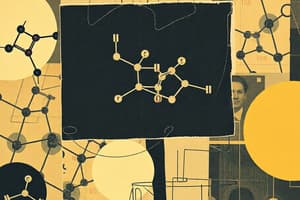Podcast
Questions and Answers
What distinguishes enantiomers from diastereomers?
What distinguishes enantiomers from diastereomers?
- Enantiomers belong to the category of conformational isomers, while diastereomers belong to a different category.
- Enantiomers can be superimposed on each other, while diastereomers cannot.
- Enantiomers have the same chemical and physical properties, but diastereomers do not.
- Enantiomers are mirror images of each other, while diastereomers are not. (correct)
What type of isomerism occurs when molecules have the same molecular formula and connectivity but differ in their three-dimensional arrangement of atoms in space?
What type of isomerism occurs when molecules have the same molecular formula and connectivity but differ in their three-dimensional arrangement of atoms in space?
- Optical isomerism
- Conformational isomerism (correct)
- Stereoisomerism
- Structural isomerism
Which pair of stereoisomers can be classified as diastereomers?
Which pair of stereoisomers can be classified as diastereomers?
- (+)- and (-)-2-butanol and (1S,2R)-2-butanol
- (+)- and (-)-2-butanol
- (1S,2R)-2-butanol and (1S,2R)-2-butanol
- (1S,2R)-2-butanol and (1R,2R)-2-butanol (correct)
What is the primary role of chiral chemistry in drug design and biologically active molecules?
What is the primary role of chiral chemistry in drug design and biologically active molecules?
How do conformational isomers differ from enantiomers and diastereomers?
How do conformational isomers differ from enantiomers and diastereomers?
Why is understanding isomerism important for organic chemists?
Why is understanding isomerism important for organic chemists?
What is the primary difference between chain isomers and functional group isomers?
What is the primary difference between chain isomers and functional group isomers?
In stereoisomerism, what makes molecules different from each other?
In stereoisomerism, what makes molecules different from each other?
Which type of isomerism occurs when molecules have the same molecular formula but differ in the way their atoms are connected?
Which type of isomerism occurs when molecules have the same molecular formula but differ in the way their atoms are connected?
What distinguishes stereoisomerism from structural isomerism?
What distinguishes stereoisomerism from structural isomerism?
How do chain isomers and functional group isomers differ?
How do chain isomers and functional group isomers differ?
Which type of isomerism arises when molecules have the same molecular formula and the same connectivity of atoms but differ in their spatial arrangement?
Which type of isomerism arises when molecules have the same molecular formula and the same connectivity of atoms but differ in their spatial arrangement?
Flashcards are hidden until you start studying
Study Notes
Exploring Isomerism in Organic Chemistry
Isomerism, a fascinating concept in organic chemistry, refers to the existence of compounds with identical molecular formulas but different arrangements of atoms, leading to distinct physical and chemical properties. This phenomenon sheds light on the creative and diverse world of organic chemistry, where carbon and its dance with other elements produce a myriad of molecules that shape our world.
There are several types of isomerism, each with its unique characteristics:
-
Structural Isomerism: This form of isomerism occurs when molecules have the same molecular formula but differ in the way their atoms are connected. There are two primary categories:
-
Chain isomers (sometimes called positional isomers) have the same functional groups but differ in the position of the functional group along the carbon chain. For instance, 1-methylbutane and 2-methylbutane are chain isomers.
-
Functional group isomers (sometimes called constitutional isomers) have the same carbon skeleton but differ in the type of functional groups attached to the carbon atoms. Ethanol and ethylene are functional group isomers.
-
-
Stereoisomerism: This form of isomerism arises when molecules have the same molecular formula and the same connectivity of atoms but differ in their spatial arrangement. There are two primary categories:
-
Enantiomers are non-superimposable mirror images of each other, which results in different chemical and physical properties. For example, (+)- and (-)-2-butanol are enantiomers.
-
Diastereomers are non-superimposable stereoisomers that are not mirror images of each other. They can be further divided into diastereomer pairs that are either cis- or trans-isomers. An example of diastereomers is the two stereoisomers of (1S,2R)-2-butanol.
-
-
Conformational Isomerism: This form of isomerism occurs when molecules have the same molecular formula and connectivity but differ in their three-dimensional arrangement of atoms in space. Conformational isomers are related by rotations around single bonds. For example, the chair and boat conformations of cyclohexane are conformational isomers.
Understanding isomerism is essential for organic chemists, as it helps them predict and manipulate the properties of molecules. Isomerism also has numerous applications, including the development of new pharmaceuticals, the determination of the structure of natural products, and the optimization of reaction pathways.
For instance, chiral isomers play a crucial role in drug design and biologically active molecules, as the two enantiomers often have distinct activities and toxicities. Chiral chemistry involves the selective synthesis, separation, and analysis of enantiomers, which can ultimately lead to improved drug efficacy and safety.
The study of isomerism continues to provide valuable insights into organic chemistry, and it remains an active area of research. With the ongoing exploration of new chemical spaces and the development of advanced techniques, the future of isomerism in organic chemistry promises to be both exciting and fruitful.
Studying That Suits You
Use AI to generate personalized quizzes and flashcards to suit your learning preferences.




